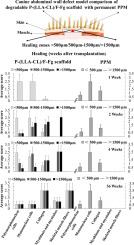Biomaterials Advances ( IF 5.5 ) Pub Date : 2020-01-08 , DOI: 10.1016/j.msec.2020.110644 Shaojie Li , Ling Su , Xiaoxia Li , Li Yang , Ming Yang , Honghai Zong , Qihua Zong , Jiangxiong Tang , Hongbing He

|
Background
The use of permanent synthetic materials for abdominal wall repair is currently the method of choice. However, they are not ideal as short-term and long-term complications have been reported for these materials including chronic groin pain (pain that lasted longer than 3 months), which occurred in 10–12% of patients, and host immunological responses to foreign body grafts. In the present randomized paired study we compared an electrospun composite scaffold composed of poly (l-lactide-co-caprolactone) [PLCL] blended with porcine fibrinogen (F-Fg) (PLCL/F-Fg), with a polypropylene mesh (PPM) as the control in a canine abdominal wall defect model (in 36 Beagle dogs).
Results
A blend ratio of 4:1 PLCL: F-Fg1 scaffold possessed optimal physical characteristics including shrinkage rate, mechanical strength, porosity and super-hydrophilic properties. Macroscopic, histological and biomechanical evaluations were performed over a period of 36 weeks and the results indicated that the resorbable PLCL/F-Fg1 electrospinning scaffold could effectively induce and augment abdominal skeletal muscle regeneration. The degradation rate of the PLCL/F-Fg1 scaffold and the rate of new tissue growth reached a balance and the biomechanical strength returned to baseline within 2 weeks of implantation. The immunohistological data demonstrated the presence of regenerated skeletal muscle tissue for PLCL/F-Fg1 scaffolds, whereas the PPM exhibited dense fibrous encapsulation along the perimeter of the mesh.
Conclusions
The data provides the foundation for future clinical applications of PLCL/F-Fg1 composite scaffolds for reconstructive surgery of abdominal wall defects.
中文翻译:

电纺聚(l-丙交酯-己内酯)和猪血纤维蛋白原支架的腹壁重建:在犬中的实验研究
背景
当前选择永久性合成材料进行腹壁修复。但是,它们并不理想,因为据报道这些材料的短期和长期并发症包括慢性腹股沟疼痛(持续时间超过3个月的疼痛),发生在10%至12%的患者中,并且对异物移植。在本随机配对的研究中,我们比较聚(构成的电纺丝复合支架升-lactide-共己内酯)[PLCL]与猪纤维蛋白原(F-FG)(PLCL / F-FG)混合,用聚丙烯网(PPM )作为犬腹壁缺损模型的对照(在36只Beagle犬中)。
结果
PLCL:F-Fg1支架的比例为4:1,具有最佳的物理特性,包括收缩率,机械强度,孔隙率和超亲水性。进行了为期36周的宏观,组织学和生物力学评估,结果表明可吸收的PLCL / F-Fg1静电纺丝支架可以有效诱导和增强腹部骨骼肌的再生。PLCL / F-Fg1支架的降解速率和新组织的生长速率达到平衡,并且生物机械强度在植入后2周内恢复到基线。免疫组织学数据表明,PLCL / F-Fg1支架存在再生的骨骼肌组织,而PPM沿网状组织的周界表现出密集的纤维包裹。
结论
该数据为PLCL / F-Fg1复合支架在腹壁缺损的重建手术中的未来临床应用提供了基础。











































 京公网安备 11010802027423号
京公网安备 11010802027423号